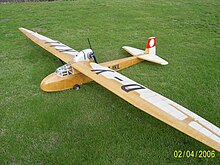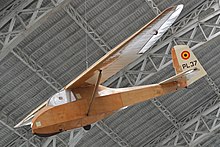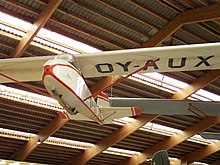Grunau baby
| Grunau baby | |
|---|---|

|
|
| Type: | Glider |
| Design country: | |
| Manufacturer: |
Edmund Schneider |
| First flight: |
1931 |
| Number of pieces: |
> 6000-7000 |
The Grunau Baby is one of the most built gliders . At least 5,000 copies were made in Germany and many other European countries between 1931 and 1945. The gliding index is 54.
history
The Grunau Baby was designed in the winter of 1930/31 by Edmund Schneider at the Grunau Gliding School (today Jeżów Sudecki ). Since Edmund Schneider was largely unknown, he asked Wolf Hirth if he could use his name to advertise the baby. Hence the wanted impression arose that the prominent Hirth was involved in the construction.
Edmund Schneider had designed the baby as a training aircraft with good flight characteristics, while the gliding performance could not keep up with that of pure performance sailors. In view of the mostly precarious financial situation of the glider clubs, a central design goal from the beginning was the possibility of license building; During the construction, Schneider made sure that the aircraft could be built according to plans by average gliding clubs with limited resources. This possibility has been used many times around the world. So today it is no longer possible to determine how many "babies" were actually built in all variants. Wolf Hirth gives a number between 10,000 and 15,000, a number around 6,000–7,000 should be more realistic, of which 4,914 alone were produced for the NSFK and later 396 for the GST . There are also around 300 Czech Zlín Z-24s and 95 Swedish Se-102s. There is no information available about the number of copies made by Nord in France. Even with this number, the Grunau Baby remains the most built glider and after the SG 38 and the Waco CG-4A the most built motorless airplane in history.
In the Third Reich, the Grunau Baby formed the basis of basic aviation training alongside the SG 38 and the DFS Kranich . After the Second World War there was practically no gliding nation in which Grunau babies or their modifications did not dominate the training business. Even after the re-authorization of gliding in West Germany on April 28, 1951, the baby played an important role again, Schleicher began series production of the Baby III and there was practically no club that did not have at least one baby. Even in 1960 more than 400 machines were still registered, although much more powerful types such as the Schleicher K 8 or the Scheibe L-Spatz were available.
construction
Originally the hull was made of wood and was planked with plywood . The single-spar wing was designed in two parts and braced towards the fuselage. The horizontal stabilizer was also braced towards the fuselage and not profiled (flat plate). A rubber-sprung runner and a spring steel spur at the rear served as the chassis.
Versions
Baby i
The first version, Baby I , had a wingspan of 12.87 m, a wing area of 14 m² and a curb weight of 98 kg. It was designed in a stripped high-deck design and had an open cockpit with a windshield. A storm cable ran from the bow to about the middle of the lower wing. About 80 copies were made.
With a self-made Baby I, Kurt Schmidt set a world record in continuous gliding at Korschenruh in East Prussia in 1933. It took off on August 3 at 7:33 a.m. and landed after 36 hours and 36 minutes on August 4 at 7:58 p.m. The 40-hour mark in continuous gliding was reached in May 1937 with 40 hours and 55 minutes by flight instructor Ernst Jachtmann on the Red Cliff on the island of Sylt . Jachtmann flew with the improved version Baby II .
Baby ii
Schneider revised his design in 1932/33. The Baby II received a wing with an auxiliary spar that was extended by 70 cm and an enlarged, more streamlined fuselage. The successor Baby IIa also received larger ailerons, a reinforced stern and a removable, open cabin cover with a windshield.
Baby iib
The most built version was the Baby IIb with Schempp-Hirth dive brakes, a higher maximum take-off mass and even larger ailerons. From 1952 to 1957 396 copies of it were produced in the GDR alone and some were used by the Society for Sport and Technology until 1979 . After the wall came down, some babies were reactivated and made airworthy again. After the Second World War, 50 more Grunau Baby 2Bs were produced by Elliots of Newbury as EoN Baby in Great Britain and production continued in Schneider's former factory in Poland. In the former Upper Carinthian aircraft factory Oberlerchner in Seeboden , aircraft were built from 1949, including the Grunau Baby IIb with a rudder that deviated from the other manufacturers.
Motor baby
In 1938 the self-launching motor glider Motor-Baby was created with a 13.2 kW engine and main landing gear instead of a skid. The engine was located behind the pilot's seat and drove a pusher propeller . The rear fuselage was strongly flattened because of the propeller and had a rectangular cross-section. At least 25 pieces were built
Baby III
In Germany at the beginning of the 1950s , Schleicher built a slightly modified version as Baby III (first flight August 24, 1951), which differed primarily in terms of a shortened runner with a central wheel behind it. The rudder and ailerons were also slightly modified.
Baby IV
By Schneider Ltd. pattern built in Australia.
Baby v
In Germany there was also a variant called Baby V as a two-seater with a closed canopy, but only six copies were produced.
The Baby V has a body made of tubular steel and fabric covering.
Cumulus
The Reinhard "Cumulus" was a derivative of a newly built tubular steel fuselage with a slim tail unit and with the wings and tail unit of the Grunau baby. About 20 pieces were built.
Others
In Romania , the IFIL R.G.-1 school sailor was developed from the Baby IIb .
In Finland , PIK developed the PIK -10 Moottoribaby motor glider based on the Baby II . The prototype with the registration OH-PXA is exhibited in the Finnish Aviation Museum.
In Scarborough , England , Slingsby Sailplanes produced around 15 copies of the Baby II as Slingsby Type 5 (T.5) Grunau Baby 2 between 1935 and 1939 . In addition, there was an unknown number of kits. The low production figures can be explained in part by the rapidly expanding range of products at Slingsby. The Type 6 Kirby Kite in particular was in direct competition with the Baby 2 , and a short time later the Type 7 Kadet and the Type 8 Tutor were added.
In France , dad Baby was built as the Nord -1300 .
In Norrköping / Sweden 95 babies were built as AB Flygplan Se-102 .
In the US , the baby was named TG-27 (Training Glider)
In Czechoslovakia after 1945 about 300 pieces of the slightly modified Baby IIb were built as Zlín Z-24 and z. Some flown with the closed canopy of the DFS crane .
Technical data Grunau Baby IIb
| Parameter | Data |
|---|---|
| overall length | 6.15 m |
| span | 13.50 m |
| height | 1.35 m |
| Wing area | 14.20 m² |
| Wing extension | 12.80 |
| Wing loading | 17.6 kg / m² |
| Glide ratio | 17 at 60 km / h |
| Slightest sinking | 0.9 m / s at 50 km / h |
| Preparation mass | 160 kg |
| Max. Takeoff mass | 250 kg |
| Top speed | 160 km / h |
| Minimum speed | 45 km / h |
Preserved copies (selection)
- Grunau Baby IIb (
D–1065) in the Schleissheim aircraft yard . - Grunau Baby IIa (
D-1079) in the German Gliding Museum - Grunau Baby III (
D-1107) in action with the Benediktbeuern glider group. - Grunau Baby III (
D-1977) of the Segelflug-Club Fischbek e. V. in Hamburg, stationed there, had an accident in Terlet on July 31, 2015, unable to fly. - Grunau Baby IIb (
D-2411, exDM-1084) privately owned, stationed at the Averbach / V flying club. e. V. at the airfield Auerbach / V. - Grunau Baby IIb (
D-3856) owned by the Oldtimer Segelflugclub Wasserkuppe e. V., stationed at the Wasserkuppe airfield . - Grunau Baby III (
D-4303) in the German Gliding Museum - Grunau Baby IIb (
D-4764) of the Quax - Association for the Promotion of Historical Aircraft e. V., based in Hamm at the Luftsportclub Hamm e. V. - Grunau Baby IIb (
D–5221) in the Osnabrück Association for Aviation eV at the Achmer airfield. - Grunau Baby III (
D-5515) owned by LSV Hünsborn (after the merger of three clubs, previously LSV Ferndorf) - Grunau Baby III (
D-6340) privately owned, stationed on the Witzenhausen-Burgberg glider airfield - Grunau Baby III (
D-8585) in the Flying Museum in Großenhain - Grunau Baby II (
HB-87) of the Basel Fricktal glider group, stationed at the Fricktal-Schupfart airfield (built in 1933, work number 90). - Grunau Baby II B-2 (
LZ–NZ) at the National Air and Space Museum (NASM) in Washington, DC - Grunau Baby IIb (
OE-0038) still flies at the Micheldorf Glider and Model Club in Upper Austria (built in 1944.) - Grunau Baby IIb (
OE-0374) is still flying at the Alpinen Sportflieger-Club Leoben (Timmersdorf) - Grunau Baby IIb (
OE-0442) still flies with the Heeresflugsportgruppe Kondor, originally from 2 specimens of the Austrian Armed Forces - Grunau Baby IIb (
OE-0449) privately owned, stationed at the Nastatten airfield. - Grunau Baby IIb (
OY-AUX) in the Dansk Veteranflysamling
See also
literature
- Peter F. Selinger: Glider Stories. The gliders and gliders of the German Glider Museum with model flight on the Wasserkuppe . Stiftung Deutsches Segelflugmuseum Wasserkuppe with model flight, Gersfeld / Rhön 2004, ISBN 3-00-011649-4 .
Web links
- grunaubaby.de : The Grunau Baby Homepage, accessed on April 25, 2015
- grunaubaby.nl : Dutch Grunau Baby website, accessed on February 13, 2020
Individual evidence
- ↑ Hugo H. Kromer: Exercise Glider "Grunau Baby" . In: Carl Oskar Ursinus (Ed.): Flugsport . No. 20 . Verlag für Flugsport, Frankfurt am Main January 20, 1932, p. 24–26 ( aviation in the luftfahrt-bibliothek.de [accessed on February 13, 2020]).
- ↑ Martin Simons: Sling's Sailplanes - Part 5 (Type 5 Grunau Baby 2). Airplane Monthly, December 1992, p. 25.
- ^ Upper Silesian State Museum: "Edmund Schneider" (PDF; 346 kB, on Schneider's Vita).
- ↑ PIK 10 Moottori Baby. In: ilmailumuseo.fi. Finnish Aviation Museum , accessed April 25, 2015 (Finnish).
- ↑ Flugwerft Schleißheim : Grunau Baby IIb, accessed on April 25, 2015.
- ^ German Glider Museum : Grunau Baby IIa, accessed on April 25, 2015.
- ^ Glider flying group Benediktbeuern : Grunau Baby III, accessed on April 25, 2015.
- ^ Aviation Safety Network , accessed August 16, 2015.
- ↑ Glider Club Fischbek e. V .: Grunau Baby III, accessed on April 25, 2015.
- ↑ Fliegerklub Auerbach / V. eV : Grunau Baby IIb, accessed on April 25, 2015.
- ^ OSC Wasserkuppe: Grunau Baby IIb. In: osc-wasserkuppe.de. Retrieved September 7, 2017 .
- ↑ German Glider Museum : Grunau Baby III, accessed on April 25, 2015.
- ^ Club-owned aircraft : Grunau Baby IIb, accessed on February 1, 2019.
- ^ Osnabrück Aviation Association : Grunau Baby IIb, accessed on April 25, 2015.
- ^ LSV Witzenhausen : Grunau Baby III, accessed on April 25, 2015.
- ↑ Flying Museum Großenhain ( page no longer available , search in web archives ) Info: The link was automatically marked as defective. Please check the link according to the instructions and then remove this notice. Retrieved April 25, 2015.
- ↑ Segelfluggruppe Basel Fricktal : Grunau Baby II, accessed on December 2, 2017.
- ^ National Air and Space Museum : Grunau Baby II B-2, accessed April 25, 2015.
- ^ Glider and Model Club Micheldorf Upper Austria. : Grunau Baby IIb, accessed on December 2, 2017
- ↑ Alpiner Sportflieger-Club Leoben (Timmersdorf) ( Memento of the original from December 12, 2014 in the Internet Archive ) Info: The archive link has been inserted automatically and has not yet been checked. Please check the original and archive link according to the instructions and then remove this notice. : Grunau Baby IIb, accessed on April 25, 2015.
- ^ Heeresflugsportgruppe Albatros : Grunau Baby IIb, accessed on April 25, 2015.
- ↑ Private ownership : Grunau Baby IIb, accessed on December 2, 2017
- ^ Danmarks Flymuseum : Schneider Grunau Baby IIb, accessed on April 25, 2015.








